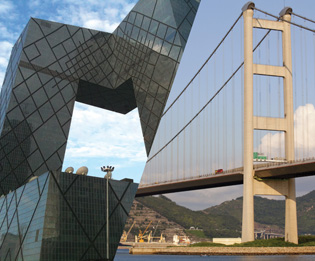When casual observers look at Stonecutters Bridge in Hong Kong, the CCTV Tower in Beijing or Shanghai Tower, they may be struck by their massive sizes or original designs. However, Prof. Xu You-lin, Chair Professor of Structural Engineering and Dean of the Faculty of Construction and Environment, has a different perspective. He sees the many technological innovations that help to keep the buildings and bridges safe and structurally sound, because he has been involved in those innovations throughout his career.
The holder of Master of Engineering Science from Tongji University and Doctor of Philosophy from the University of Sydney, Prof. Xu has participated in many major construction projects, in both Hong Kong and the Chinese mainland. His work played a major part in the structural health monitoring of Hong Kong’s Stonecutters Bridge and Tsing Ma Bridge. The latter, completed in 1997, is among Prof. Xu’s proudest achievements.
It was in this project that Prof. Xu promoted structural health monitoring, which at that time was mostly unknown in Hong Kong. The bridge has incorporated several innovative systems to monitor wind speed, temperature and traffic volume. In this way the government can stay up to date on the status of the bridge and plan repairs to prevent any serious faults. These systems, though novel at the time, have become a standard part of new bridge construction projects.

Prof. Xu contributed to the structural field measurement and health monitoring of CCTV Tower in Beijing (left) and Tsing Ma Bridge (right).
Prof. Xu’s work extends beyond the practical aspects of construction, of course. He can claim over 200 papers in prestigious international journals, and has served on the editorial boards of such prominent publications as the Journal of Bridge Engineering and the Journal of Civil Structural Health Monitoring. In addition, Prof. Xu has written the books Structural Health Monitoring of Long-Span Suspension Bridges and Wind Effects on Cable-Supported Bridges.
A member of several professional organizations, Prof. Xu has earned the rank of Fellow at the Hong Kong Institution of Engineers, the American Society of Civil Engineers, the Engineering Mechanics Institute in the US, and the Institution of Structural Engineers in the UK. He won the 2012 Robert H. Scanlan Medal from the American Society of Civil Engineering and is the recipient of the 2006 Croucher Senior Research Fellowship, Hong Kong’s most prestigious research award.
Despite his many achievements, Prof. Xu is still looking to the future. In addition to his work on structural health monitoring, he is eager to find new ways to make artificial objects and the environment work together. For example, he has envisaged taking advantage of Hong Kong’s strong winds by adding wind power generators to the buildings and bridges. Thanks to the work of Prof. Xu and his colleagues at PolyU, future generations both in Hong Kong and throughout China will inherit a sturdy architectural heritage. ♦

